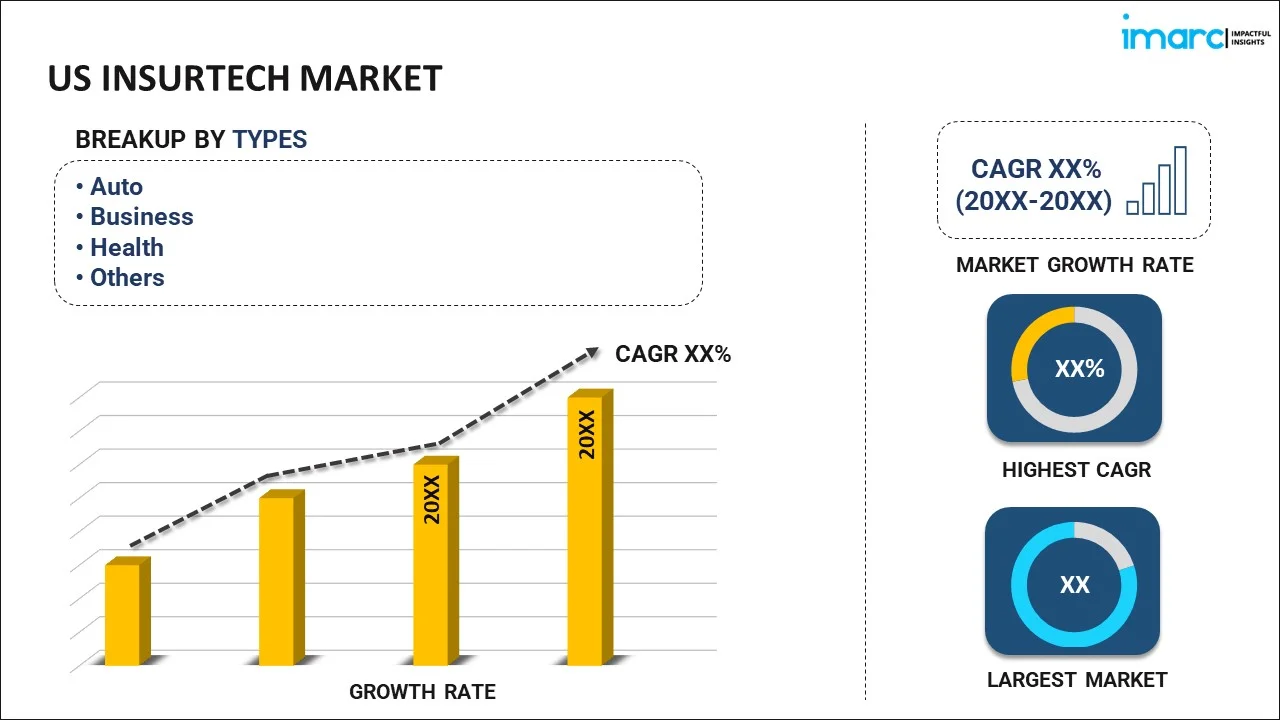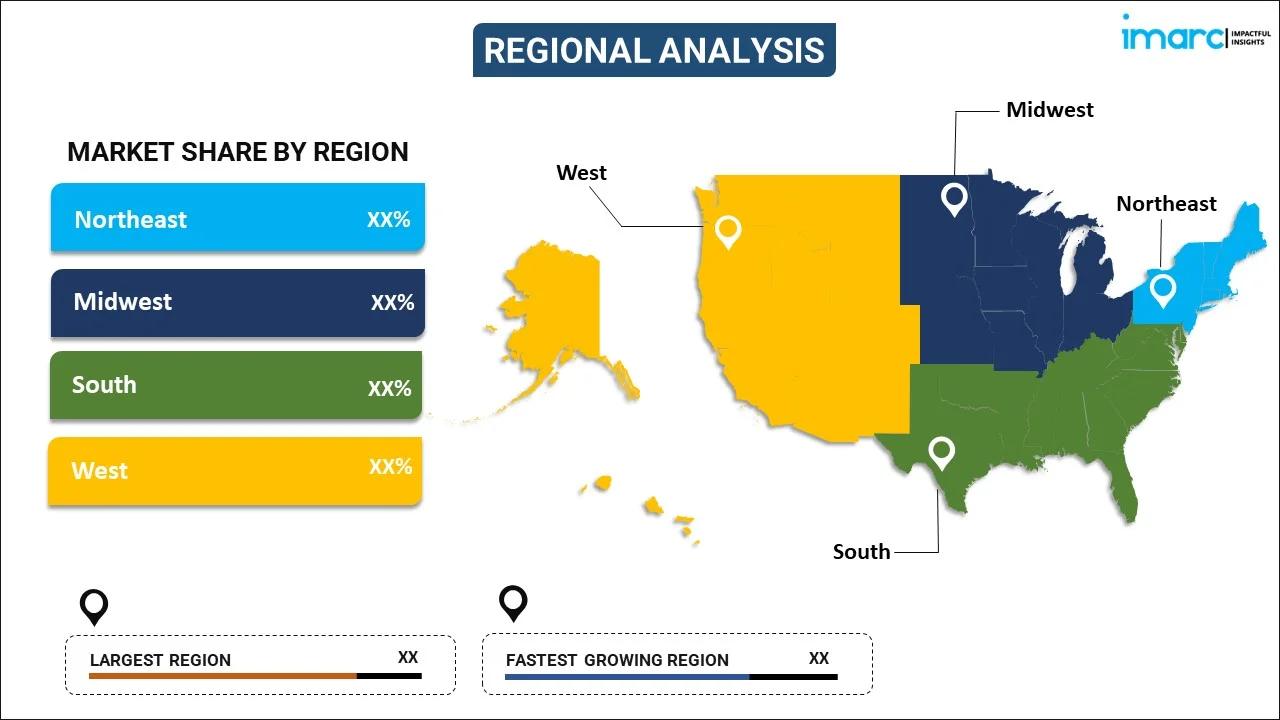
US Insurtech Market Report by Type (Auto, Business, Health, Home, Specialty, Travel, and Others), Service (Consulting, Support and Maintenance, Managed Services), Technology (Blockchain, Cloud Computing, IoT, Machine Learning, Robo Advisory, and Others), and Region 2025-2033
Market Overview:
US insurtech market size reached USD 2,542.2 Million in 2024. Looking forward, IMARC Group expects the market to reach USD 4,368.4 Million by 2033, exhibiting a growth rate (CAGR) of 6.20% during 2025-2033. The rapid evolution of technology, particularly in areas such as artificial intelligence, machine learning, blockchain, and data analytics, which has enabled innovative solutions in the insurance sector, is bolstering the US insurtech market share.
|
Report Attribute
|
Key Statistics
|
|---|---|
|
Base Year
|
2024
|
|
Forecast Years
|
2025-2033
|
|
Historical Years
|
2019-2024
|
|
Market Size in 2024
|
USD 2,542.2 Million |
|
Market Forecast in 2033
|
USD 4,368.4 Million |
| Market Growth Rate 2025-2033 | 6.20% |
US Insurtech Market Analysis:
- Key Market Trends: Expansion of the market is marked by rising venture capital funding, collaboration between technology start-ups and conventional insurers, and expanding use of Internet of Things (IoT) devices to capture real-time data and assess risk in insurance activities.
- Major Drivers: The market is spurred by accelerated technological innovation in artificial intelligence (AI), machine learning (ML), and blockchain technologies. Digital transformation efforts by legacy insurers, growing consumer needs for personalized insurance products, and regulatory encouragement for innovation drive is fueling the US insurtech market growth.
- Market Challenges: The regulatory complexities of compliance, the cybersecurity threats with online platforms, and consumer trust in embracing new technologies. Integration challenges of legacy systems and data privacy issues are major obstacles to mass insurtech adoption among different segments of insurance.
- Market Opportunities: Artificial intelligence (AI) underwriting, blockchain-based smart contracts, and usage-based insurance models are some of the main opportunities in the market. Market penetration growth in underinsured markets and creating innovative risk management solutions are large growth opportunities for insurtech firms.
Insurtech, short for insurance technology, refers to the innovative use of technology to enhance and streamline the insurance industry. This rapidly evolving sector leverages advancements such as artificial intelligence, big data analytics, blockchain, and digital platforms to improve various aspects of the insurance lifecycle. Insurtech aims to enhance customer experiences by simplifying the purchase process, optimizing underwriting through data analysis, and expediting claims processing. Additionally, it fosters the development of new insurance models, such as usage-based policies and peer-to-peer insurance. By embracing digital solutions, insurtech not only increases operational efficiency but also fosters greater accessibility and affordability of insurance products, ultimately reshaping and modernizing the traditional insurance landscape.
US Insurtech Market Trends:
Artificial Intelligence and Machine Learning Integration
The convergence of artificial intelligence and machine learning technologies is the most substantial shift in the US insurtech market analysis. The technologies are transforming the conventional insurance practices by making automated underwriting, fraud detection, and risk assessment abilities possible. Chatbots and virtual assistants powered by AI are improving the customer service experience through 24/7 assistance and instant access to policy details. Machine learning algorithms parse huge datasets to determine patterns and predict claim likelihood with unmatched precision. This technological prowess enables insurers to deliver more customized pricing models and cut operation costs substantially. AI-led predictive analytics also enable insurers to identify potential risks proactively and adopt preventive measures, thereby enhancing customer satisfaction and lowering claim frequencies in different insurance segments.
Internet of Things (IoT) and Connected Devices Adoption
The growth of IoT devices is changing the way insurance providers gather data and estimate risks in real time. Home automation devices, fitness trackers, and connected cars systems offer a constant flow of data that can be used to profile risks more accurately and develop dynamic pricing frameworks. Telematics sensors in cars monitor driving habits, enabling auto insurers to provide usage-based insurance policies that reward good driving habits. In health insurance, wearable technology tracks vital signs and activity levels, allowing insurers to reward healthy lifestyle habits through premium rebates. Property insurers use smart home sensors to identify potential risks such as water leaks, fire hazards, or security intrusions, allowing for proactive risk management. This movement towards real-time data gathering and analysis is developing more transparent, equitable, and personalized insurance products that serve the interests of both insurers and policyholders with enhanced risk management and lower costs.
Blockchain Technology and Smart Contracts Implementation
Blockchain technology is becoming a revolutionary agent in the US insurtech industry, providing improved security, transparency, and efficiency in insurance business. Blockchain-based smart contracts automate claims settlement, cutting processing time from weeks to minutes without human error and the risk of fraud. The technology facilitates transparent and immutable record-keeping, allowing all policy transactions and claims to be irreversibly recorded and easily auditable. Blockchain enables easy data sharing among insurance providers, healthcare services, and regulatory agencies while ensuring data security and privacy requirements. Blockchain-based parametric insurance products also automatically give the payment when conditions are met based on pre-determined criteria like weather or flight delays without traditional claims investigations. The adoption of blockchain technology is decreasing administrative expenses, enhancing customer confidence, and making it possible for new insurance product innovations that were not possible with existing systems thereby driving the US insurtech market demand.
US Insurtech Market Segmentation:
IMARC Group provides an analysis of the key trends in each segment of the market, along with forecasts at the country level for 2025-2033. Our report has categorized the market based on type, service, and technology.
Type Insights:

To get more information on of this market, Request Sample
- Auto
- Business
- Health
- Home
- Specialty
- Travel
- Others
The report has provided a detailed breakup and analysis of the market based on the type. This auto, business, health, home, specialty, travel, and others.
Service Insights:
- Consulting
- Support and Maintenance
- Managed Services
A detailed breakup and analysis of the market based on the service have also been provided in the report. This includes consulting, support and maintenance, and managed services.
Technology Insights:
- Blockchain
- Cloud Computing
- IoT
- Machine Learning
- Robo Advisory
- Others
The report has provided a detailed breakup and analysis of the market based on the technology. This includes blockchain, cloud computing, IoT, machine learning, robo advisory, and others.
Regional Insights:

- Northeast
- Midwest
- South
- West
The report has also provided a comprehensive analysis of all the major regional markets, which include Northeast, Midwest, South, and West.
Competitive Landscape:
The market research report has also provided a comprehensive analysis of the competitive landscape. Competitive analysis such as market structure, key player positioning, top winning strategies, competitive dashboard, and company evaluation quadrant has been covered in the report. Also, detailed profiles of all major companies have been provided.
Recent News and Development:
- In September 2025, A new insurtech platform, The Spark, slaunched at Monte Carlo’s annual Rendez-Vous as the “world’s first global prevention lab.” Backed by Aon, Generali, and QBE Ventures, it aims to shift insurance from claims-paying to loss-prevention. The platform seeks to reduce claims through innovative technologies, with global insurers representing over $300 billion in premiums participating. Prevention-focused revenue for U.S. insurers is projected to rise from $21.6B in 2023 to $49.5B by 2030.
- In August 2025, Hiscox USA agreed to acquire Corix Insurance Services LLC and Vouch Insurance Company from Vouch Inc., targeting small businesses in technology, life sciences, and professional services. The deal expands Hiscox’s U.S. specialty insurance reach and adds new broker technology, while Vouch Inc. will focus on risk management services. A multi-year distribution agreement between the companies supports continued collaboration, pending regulatory approval.
US Insurtech Market Report Coverage:
| Report Features | Details |
|---|---|
| Base Year of the Analysis | 2024 |
| Historical Period | 2019-2024 |
| Forecast Period | 2025-2033 |
| Units | Million USD |
| Scope of the Report | Exploration of Historical Trends and Market Outlook, Industry Catalysts and Challenges, Segment-Wise Historical and Future Market Assessment:
|
| Types Covered | Auto, Business, Health, Home, Specialty, Travel, Others |
| Services Covered | Consulting, Support and Maintenance, Managed Services |
| Technologies Covered | Blockchain, Cloud Computing, IoT, Machine Learning, Robo Advisory, Others |
| Regions Covered | Northeast, Midwest, South, West |
| Customization Scope | 10% Free Customization |
| Post-Sale Analyst Support | 10-12 Weeks |
| Delivery Format | PDF and Excel through Email (We can also provide the editable version of the report in PPT/Word format on special request) |
Key Benefits for Stakeholders:
- IMARC’s industry report offers a comprehensive quantitative analysis of various market segments, historical and current market trends, market forecasts, and dynamics of the US insurtech market from 2019-2033.
- The research report provides the latest information on the market drivers, challenges, and opportunities in the US insurtech market.
- Porter's five forces analysis assist stakeholders in assessing the impact of new entrants, competitive rivalry, supplier power, buyer power, and the threat of substitution. It helps stakeholders to analyze the level of competition within the US insurtech industry and its attractiveness.
- Competitive landscape allows stakeholders to understand their competitive environment and provides an insight into the current positions of key players in the market.
Key Questions Answered in This Report
The insurtech market in the US was valued at USD 2,542.2 Million in 2024.
The US insurtech market is projected to exhibit a (CAGR) of 6.20% during 2025-2033, reaching a value of USD 4,368.4 Million by 2033.
The market is driven by insurance digital transformation, increasing use of AI, IoT, and blockchain technologies, and increasing consumer needs for customized, speedy, and affordable services. Support from regulators, heightened venture capital investment, and the necessity for streamlined claims handling and risk assessment also fuel the market's swift growth.
Need more help?
- Speak to our experienced analysts for insights on the current market scenarios.
- Include additional segments and countries to customize the report as per your requirement.
- Gain an unparalleled competitive advantage in your domain by understanding how to utilize the report and positively impacting your operations and revenue.
- For further assistance, please connect with our analysts.
 Request Customization
Request Customization
 Speak to an Analyst
Speak to an Analyst
 Request Brochure
Request Brochure
 Inquire Before Buying
Inquire Before Buying




.webp)




.webp)












